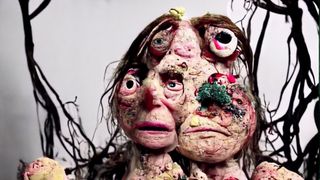AI image generator births the horrific 'first cryptid of the latent space'
I'm not sleeping tonight. Loab is everywhere.

As the AI image generation trend continues unabated, so too grows the lore. It appears there are stranger forces at work here than we first anticipated as, in the wake of this new creative wave, a cryptid is born.
She is known only as Loab.
Created accidentally through a series of negatively weighted prompts, Loab's macabre facade has persisted across countless image iterations, even when the AI is asked to move as far away from the subject matter as possible.
Instead of a typical AI art prompt, which tells the machine learning software what kind of image you want to see (eg, "Geralt in his tub"), a negatively weighted image prompt tells an AI to make an image "look as different from the prompt as possible," Supercomposite explains. Supercomposite is the AI image generation artist responsible for this cryptid's existence, and will henceforth undoubtedly become known as the mother of Loab, which I'm sure she's delighted about.
Cryptids are entities such as Bigfoot or the Loch Ness Monster which are not generally recognised by science, but whose image is recognised through multiple supposed sightings. Loab is supposedly the "first cryptid of the latent space," though there's some (albeit insubstantial) debate surrounding those claims.
Feeding the AI the negative prompt "Brando::-1" was how it all began, says Supercomosite. The AI's take on the opposite of "Brando" turned out to be what looked like a logo for an imaginary company called "DIGITA PNTICS". Naturally, Supercomosite wondered if the opposite of the logo would be a picture of Marlon Brando, so she wrote another negative prompt: "DIGITA PNTICS skyline logo::-1." Instead of Marlon Brando, however, that prompt returned "off-putting images, all of the same devastated-looking older woman with defined triangles of rosacea(?) on her cheeks."
🧵: I discovered this woman, who I call Loab, in April. The AI reproduced her more easily than most celebrities. Her presence is persistent, and she haunts every image she touches. CW: Take a seat. This is a true horror story, and veers sharply macabre. pic.twitter.com/gmUlf6mZtkSeptember 6, 2022
Supercomposite didn't stop there. She used an image of Loab itself as a prompt in tandem with another AI-generated image of a "hyper compressed glass tunnel surrounded by angels [...] in the style of Wes Anderson," and the face became even clearer.
The biggest gaming news, reviews and hardware deals
Keep up to date with the most important stories and the best deals, as picked by the PC Gamer team.
"Through some kind of emergent statistical accident, something about this woman is adjacent to extremely gory and macabre imagery in the distribution of the AI's world knowledge," Supercomposite claims.
And so it went on from there, with Loab's face continuing to turn up time after time. And that's weird.
"Most celebrities get more distorted after being put through an image prompt," Supercomposite told us. "Loab pretty much stays the same even after several generations of feeding the results back into the AI."
Essentially, where most faces morph into something new, Loab manages to stay consistently recognisable even as her face is cross-pollinated with other images. When she did disappear, she "would sometimes reappear, later down the line," as if the AI just can't let go of her.

"Since Loab was discovered using negative prompt weights, her gestalt is made from a collection of traits that are equally far away from something," Supercomposite explained in one tweet. "But her combined traits are still a cohesive concept for the AI, and almost all descendent images contain a recognizable Loab.
"The AI can latch onto the idea of Loab so well that she can persist through generations of this type of crossbreeding, without using the original image."
Supercomposite, although being much more well versed in the inner workings of AI than I, admits that she doesn't fully understand what's going on here.
"I haven't experimented extensively with it but it seems like this pattern holds for multiple AIs, perhaps due to them all using CLIP in one way or the other," she said. "Or maybe it's a quirk of the RAION dataset. I'm not sure exactly why, even if I generally understand in principle how! Neural networks are a black box as they say."

Best CPU for gaming: The top chips from Intel and AMD
Best gaming motherboard: The right boards
Best graphics card: Your perfect pixel-pusher awaits
Best SSD for gaming: Get into the game ahead of the rest
She has asked me to keep the name of the AI secret as many of the images generated of Loab contain excessive gore, and I'm sure whatever company is involved doesn't fancy that kind attention.
The founder of AI image generating Discord bot Midjourney made a relevant remark in an interview with me a few weeks ago: "Obviously, it doesn't matter if there's a little bit of gore. But the problem is that you have 10,000 people who want to do gore all day. Then we produce more gore content in one month than all of human visual history. I don't know if we need that."
So whichever AI it is that has this strange obsession with the cryptid Loab, we can only wait to see what other dark and wonderful anomalies will rear their heads as the AI image generation trend continues to snowball.

Screw sports, Katie would rather watch Intel, AMD and Nvidia go at it. Having been obsessed with computers and graphics for three long decades, she took Game Art and Design up to Masters level at uni, and has been rambling about games, tech and science—rather sarcastically—for four years since. She can be found admiring technological advancements, scrambling for scintillating Raspberry Pi projects, preaching cybersecurity awareness, sighing over semiconductors, and gawping at the latest GPU upgrades. Right now she's waiting patiently for her chance to upload her consciousness into the cloud.
Most Popular


